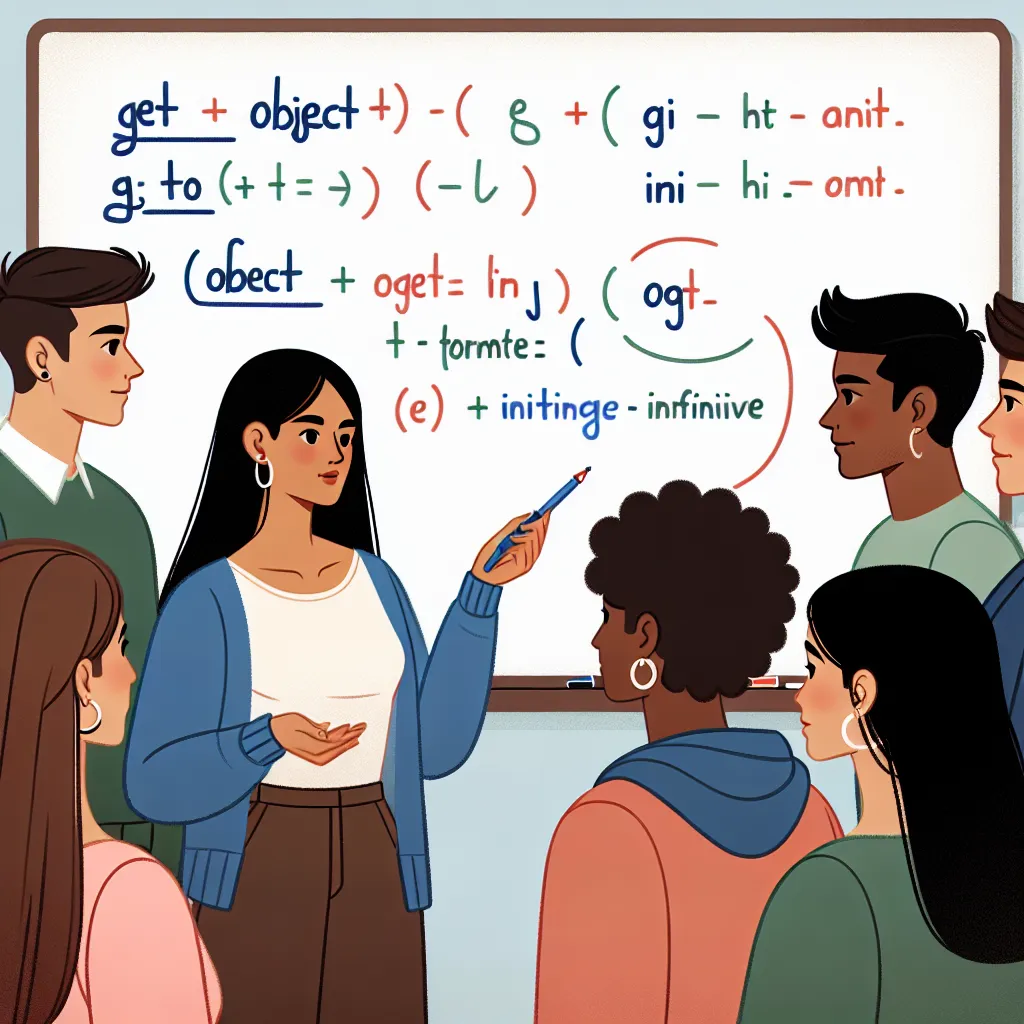The “get + object + to + infinitive” structure is a powerful and versatile grammatical construction that frequently appears in IELTS exams. Understanding and using this structure effectively can significantly enhance your performance across all sections of the test. Let’s dive into its intricacies and explore how to leverage it for IELTS success.
Understanding the “Get + Object + To + Infinitive” Structure
The “get + object + to + infinitive” structure is used to express the idea of persuading, convincing, or causing someone to do something. It’s a common construction in both spoken and written English, making it particularly relevant for IELTS candidates.
Examples:
- I got my friend to help me with my IELTS preparation.
- The teacher got the students to practice speaking every day.
- She got her parents to support her decision to study abroad.
In these sentences, the structure follows the pattern: get + [person/object] + to + [verb in base form]. This construction is especially useful in IELTS Writing and Speaking tasks where you need to describe actions, influences, or persuasion.

Grammar and Usage in IELTS Context
Formula and Grammatical Analysis
The basic formula for this structure is:
[Subject] + get + [object] + to + [base form of verb]
Let’s break down the components:
- Subject: The person or thing causing the action
- Get: The main verb in this structure
- Object: The person or thing being persuaded or caused to do something
- To: Connector between the object and the infinitive
- Base form of verb: The action that the object is being persuaded to do
This structure is particularly useful in IELTS tasks where you need to demonstrate the ability to express complex ideas and relationships between actions and people.
Application in IELTS Writing
In IELTS Writing Task 2, you can use this structure to discuss societal changes, personal influences, or policy impacts. For example:
“Governments should get citizens to reduce their energy consumption through education and incentives.”
Here’s a sample paragraph using this structure:
“To address environmental concerns, it’s crucial that authorities get people to adopt more sustainable lifestyles. They can get schools to implement environmental education programs, which in turn will get students to understand the importance of conservation. Moreover, offering tax incentives can get businesses to invest in green technologies.”
Utilization in IELTS Speaking
In the Speaking test, this structure can help you express ideas about influence and persuasion more eloquently. For instance:
Examiner: “Describe a time when you convinced someone to do something.”
Candidate: “I once got my reluctant friend to join a volunteer program. At first, he was hesitant, but I got him to see the benefits of community service. Eventually, I got him to commit to a weekly schedule, and he ended up loving the experience.”
Advanced Usage for Higher Band Scores
To aim for higher band scores (7+), it’s essential to use this structure accurately and in combination with other advanced grammatical forms. Here are some sophisticated examples:
-
Combining with perfect tenses:
“By the time the project deadline arrived, I had gotten my team to complete all the major tasks.” -
Using in passive constructions:
“The new policy was designed to get more citizens to participate in local government.” -
Incorporating into conditional sentences:
“If we could get more people to understand the importance of voting, we might see higher turnout rates in elections.” -
Employing with modals for nuance:
“The company should try to get its employees to embrace the new technology rather than forcing it upon them.” -
Using in reported speech:
“The manager said that he would get the staff to improve their customer service skills.”
These advanced applications demonstrate a high level of grammatical control and versatility, which are key factors in achieving higher band scores in IELTS.
Common Mistakes to Avoid
When using the “get + object + to + infinitive” structure, IELTS candidates often make the following errors:
-
Incorrect verb form after ‘to’:
Incorrect: “I got my sister to studying harder.”
Correct: “I got my sister to study harder.” -
Omitting ‘to’:
Incorrect: “The teacher got the studentspracticemore.”
Correct: “The teacher got the students to practice more.” -
Confusing with similar structures:
Incorrect: “I got used to wake up early.” (This is a different structure: ‘get used to + gerund’)
Correct: “I got used to waking up early.” -
Overusing the structure:
While it’s a useful construction, overusing it can make your speech or writing sound repetitive. Vary your sentence structures for a more natural flow. -
Using with non-person objects inappropriately:
Be cautious when using this structure with inanimate objects. While “I got the car to start” is acceptable, “I got the book to open” sounds unnatural. In such cases, a different structure would be more appropriate.
Conclusion
Mastering the “get + object + to + infinitive” structure can significantly enhance your IELTS performance. It allows you to express complex ideas about influence and causation elegantly and accurately. Practice incorporating this structure into your writing and speaking, paying attention to context and avoiding common errors. Remember, while it’s important to showcase your grammatical knowledge, natural and varied language use is key to achieving a high band score in IELTS.
For further practice, try using this structure in sample IELTS tasks, such as describing a time you persuaded someone, discussing methods to encourage public participation in community projects, or explaining how governments can influence citizen behavior. By mastering this versatile structure, you’ll be well-equipped to tackle a wide range of IELTS topics with confidence and linguistic sophistication.